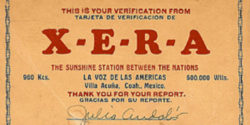Subscribe: RSS
Radio waves don’t obey borders, and stations have been taking advantage of this fact since the dawn of the medium – often despite the rules of government regulators where the signals go.
Dr. Kevin Curran of Arizona State University has been studying border radio stations extensively, making it the subject of his doctoral dissertation. Everyone has a ton of radio nerd fun as he takes us back to the 1920s, when Canadian and U.S. regulators struck a treaty to split up the AM dial and limit maximum broadcast power, but left out Mexico. That opened up an opportunity for stations in that country to cover the continent with hundreds of kilowatts, attracting broadcasters from north of the border wanting to take advantage.
Many infamous and colorful personalities were amongst this group, from Dr. John Brinkley, who promoted goat glands to cure male potency problems, all the way to man named Bob Smith – later known as Wolfman Jack – who blasted rock and roll that most American stations wouldn’t touch.
Dr. Curran explains why stations along the Mexican border remained popular with U.S. broadcasters even after that country lowered maximum power levels, in treaty with its northern neighbor. He also explores the relationship of U.S. stations to Canadian markets, where stations are more highly regulated. If you’ve ever wondered why radio is different along the border, you’re curiosity will be satisfied.
This episode was originally recorded and aired in September of 2019 as episode #212
Show Notes:
- Radio World: Goat Gland Man Has Enduring Appeal; Though His Remains Are Safely Entombed in Memphis, Dr. Brinkley’s Legend Lives on
- Wide Open Country: How Border Radio Helped Popularize Country Music
- Texas State Historical Association: Border Radio
- SpectacularOptical: Clap for the Wolfman
- The Classic CKLW Page
- Wolfman Jack biography
- Wikipedia: XEROK-AM



